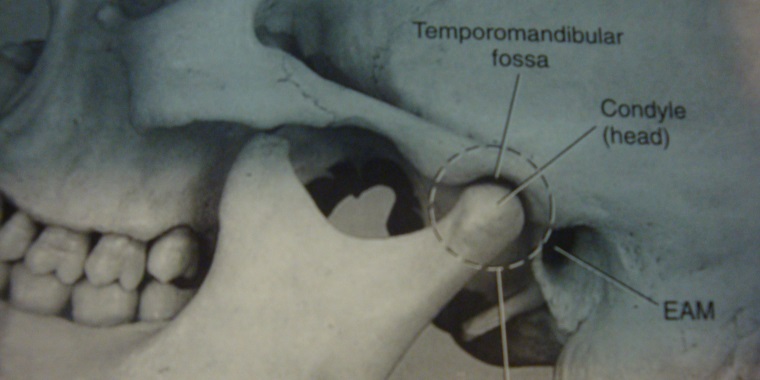TMJ (Temporomandibular Joint) Dysfunction is one of the most commonly misunderstood and mistreated diseases. Every TMJ patient is unique, and the key to eliminating TMJ pain is to find the source of the dysfunction that is causing the pain. Time for a little anatomy lesson (hang in there, i'll try to make it simple). The TMJ is made up a hinge joint where the Condyle(the part of the jaw bone that connects to the skull) fits into a Fossa(a cup to hold the Condyle of the jaw). The TMJ is mostly meant to open and close like a door (hence the term hinge joint); however, there is also some "side to side" movement as well. Think of a cow slowing chewing grass.
In the middle of the joint is a Disc, a cushion of sorts, between the condyle and fossa to prevent the bones from directly rubbing together, thereby reducing friction and preventing...PAIN. As the jaw opens, the condyle should move forward in the fossa and the disc should travel with it; however, in some situations the disc becomes "stuck" and the condyle must then "Pop" off the disc to continue to open. As the jaw closes, the condyle will once again "Pop" back onto the disc. This is why it is common for patients with TMJ pain to report popping, clicking or other noises in the jaw when they chew or open their mouth.
There are numerous positions for the disc or condyle to get stuck, or what Chiropractors refer to as Subluxate. Some people have problems opening their mouth at all, others only at the very end. Often the patient can open their mouth fully, but there is a zig-zag pattern as one side moves more than the other. Figuring out where the jaw is getting stuck is the key, once a Chiropractor properly diagnoses your TMJ problem he/she can immediately begin to correct the mis-alignment(Subluxation) and provide exercises and stretches to perform at home.
There is also an important relationship between the TMJ and the first vertebra. Even though it is hard to tell from the outside, the first vertebra actually sits directly adjacent to the TMJ. Any small misalignment (Subluxation) of the first vertebra can result in a compensatory misalignment (Subluxation) of the jaw. Since most patients present with both conditions, it is common for the Chiropractor to treat both regions at the same time.
While not every patient with TMJ finds success with Chiropractic intervention, it is our belief that Natural methods of healing should always be attempted before expensive and dangerous jaw reconstructive surgery is performed. Most surgeons in Charlotte require conservative management (through chiropractic or physical therapy) before surgery anyway. Not all TMJ problems are related to the above example, if you have any questions please feel free to schedule a free consultation or use the "Ask a Question" button above.


